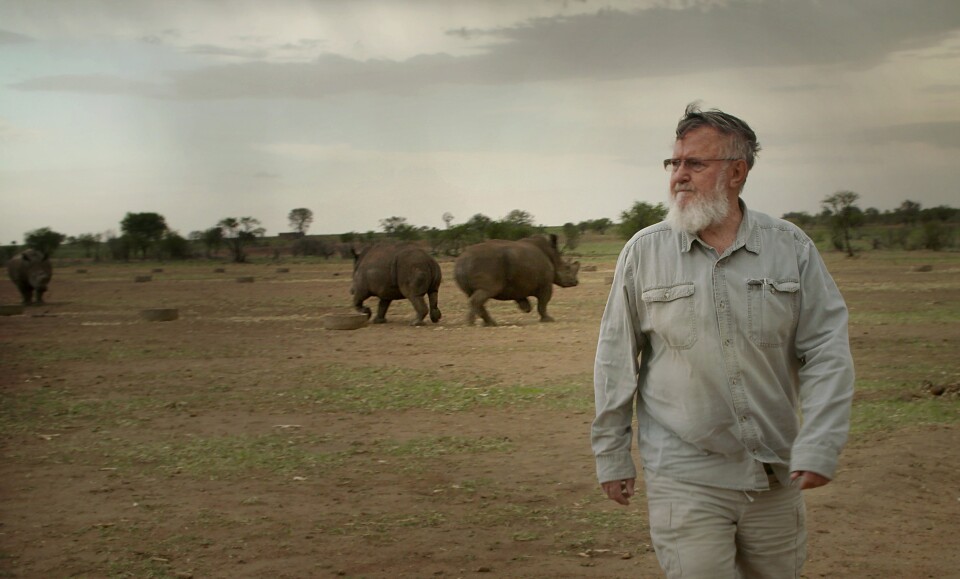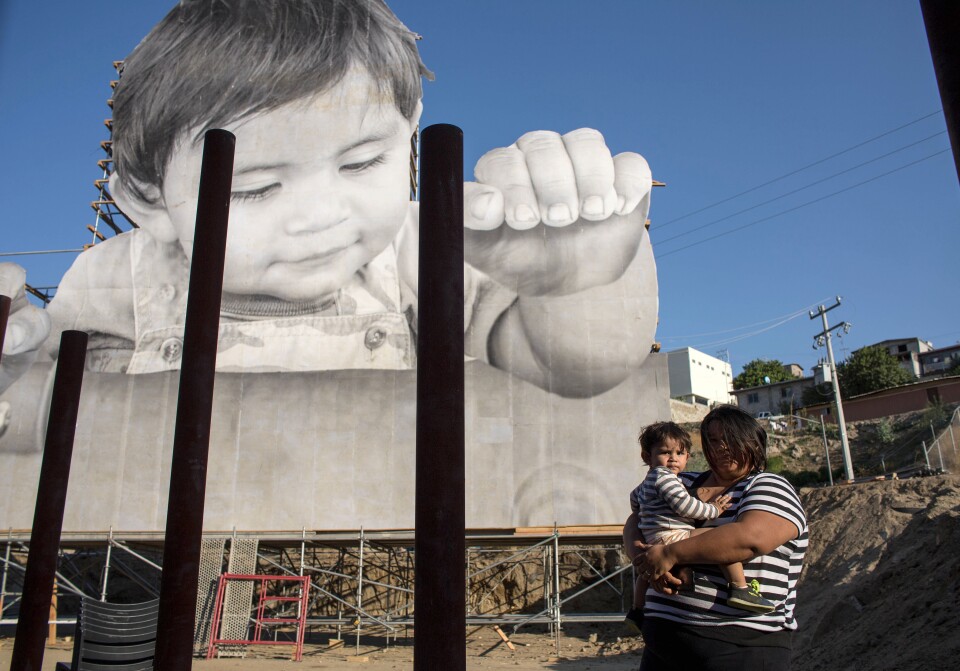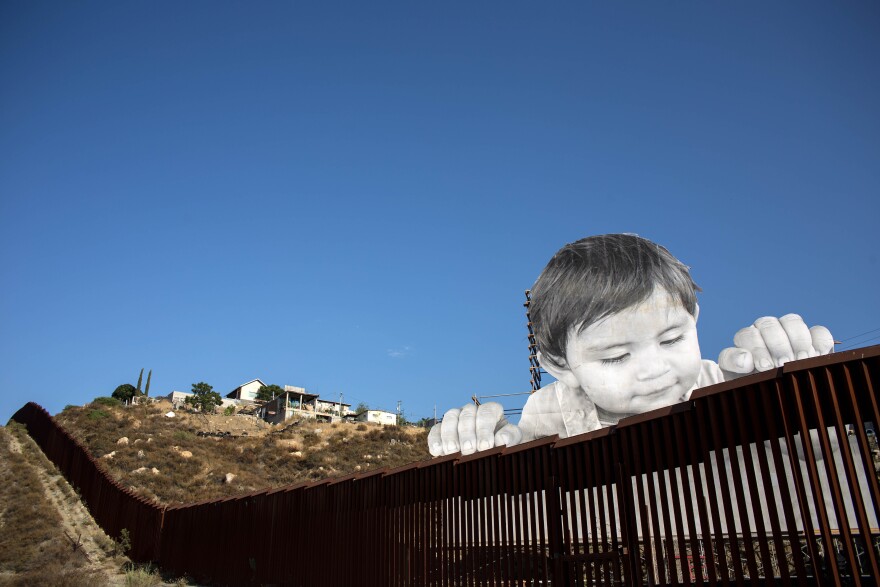The French street artist JR has installed a provocative image on the U.S.-Mexico border; Oscar's new president, John Bailey, inherits big challenges; "Trophy" examines the politics and controversy of big-game hunting.
John Bailey: Academy's new president says he doesn't fear Netflix and Amazon
Being the president of the Academy of Motion Picture Arts and Sciences can be a perilous job. You get blamed for much of what’s wrong in Hollywood — like why the industry remains so white and male — and it’s not really that easy to reinvent the Oscars.
The new academy president is John Bailey. He’s a veteran cinematographer with credits on “As Good As It Gets,” “Ordinary People,” “Groundhog Day,” "Mishima," and many other films.
When we spoke with Bailey recently at the Telluride Film Festival, he discussed getting the academy’s nearly $400-million museum completed, and how he hopes to broaden the academy’s membership.
INTERVIEW HIGHLIGHTS:
On whether he's concerned about plummeting attendance in theaters and more people watching films on streaming services:
Box office always waxes and wanes. We go through cycles and I think we're approaching a cycle now where maybe general audiences have had a surfeit of comic book movies. And digital video games are becoming so sophisticated and the resolution is so good now that the difference between what you can do interactively on your computer on a video game and what you actually watch in a movie has narrowed to quite an extent. We're also maybe in a transition period where audiences are now thinking about maybe more human relationship-oriented films. If you look at Netflix and Amazon, for example, as kind of flagships for what can happen in the future of exhibition — whether it's large screen, whether it's streaming or whatever — both Netflix and Amazon are very, very active in making motion pictures. I had a brief meeting the other day with [Netflix chief content officer] Ted Sarandos and one of the first things he told me was, "You know, Netflix is interested in big screen movies. Yes, we're going to be streaming them, but that doesn't mean we want to abandon or work around the large screen movies."
On why he wanted the job of academy president:
Well, I was drafted in a way. I had first been a governor back in '96, a year after my wife Carol Littleton had her first year as a governor. And I served for six years, then kind of got swept away for about eight or nine years of shooting two and three movies a year. And then found myself again in 2010 being elected as a governor. And then three years ago I became a VP and chair of preservation and history, which has been one of my longstanding obsessions. And then eventually a slow drafting process to become president.
On his top priorities as academy president:
The museum, obviously, is a very top priority because it's been a long-held dream for many generations of filmmakers. It's going to be really a very interactive space. It will represent international cinema as well as Hollywood cinema, and that is a very high priority and the fundraising has been very strong.
The other thing that's obviously very important is continuing, even expanding, the diversity initiative represented in the A2020 committee. And we are asking all 27 branches plus the members at large ... to form a diversity subcommittee and that subcommittee will essentially, during the entire year, look around, watch films, look for international filmmakers and filmmakers that are emerging who are truly qualified and artistic. They will then form a list so that when the executive committee for each of the branches comes together for the meeting where they consider new membership, a lot of those people will already be vetted.
And obviously the Herrick Library and the Academy Film Archive are great loves of mine. We are now trying to bring together programs that use them in a synergistic way because that will become very important for screening programs at the museum.
On broadening the Academy's membership, but still making sure new members have sufficient credits:
That's going to be one of the questions that's going to be discussed — what constitutes the sufficient level of experience? One case in point: I like talking about this cinematographer, Jose Luis Alcaine. He was born in Tangier. He's worked for many years in Spain. He's photographed a number of Pedro Almodóvar's films. He's now doing a film in Madrid with Asghar Farhadi, who won the Academy Award for his last film, "The Salesman." [Alcaine] is 79-years-old and has 155 credits if you look at IMDB. So on one hand you could say, Why wasn't this man in the Academy 40 years ago?
Another example is a younger cinematographer/documentarian named Ernesto Pardo ... I think he has fewer than a dozen credits and he's not at all know in this country. But he did photograph this amazing documentary about some Mexican women on a bus ride from Ciudad Juarez where they were essentially ransomed back to their home village. It's done very simply, but it's the most extraordinarily moving and beautiful trip through the heartland of Mexico. And a lot of us in the [American Society of Cinematographers] saw that film ... and became very curious about this beautiful documentarian. And his name came up when we were considering new membership.
So I think this diversity program, one of the keys to it, is the Academy itself reaching out. In the past, so many people, especially internationally, never became members because they had no idea that they could or how it could happen.
To hear John Horn's full interview with John Bailey, click on the player above.
Director Shaul Schwartz exposes big game hunting in 'Trophy'
In 2015, when Cecil the lion was killed by an American dentist on a big game hunt in Africa, the image went viral and created an uproar online. But it also brought to light the culture in which people pay huge amounts of money to visit fenced-in game reserves where, like some sort of theme park attraction, they can hunt "The Big Five" — lion, leopard, buffalo, rhino, and elephant.
The new documentary, "Trophy," (opening 9/8 in NY; 9/15 in LA) goes inside this world, where many of the hunters see themselves as participating in an effort to conserve the animal kingdom, even while they’re shooting for sport and collecting taxidermy to hang in their living rooms.
"Trophy" is directed by Shaul Schwartz and Christina Clusiau. When Schwartz stopped by The Frame, he talked about how they wanted to make people think about this issue through a broader lens.
INTERVIEW HIGHLIGHTS:
What Schwartz wanted to show in "Trophy":
What the film wants to point out is the complexity of the issue, and the complexity of the issue does come back to: we do domesticate animals, we have for thousands of years. We use them in quite a lot of ways, the majority of us do. You know, if you're a vegan and you just don't use animals, you don't use leather, I hear this. You got an argument. I'm not that. So that's what kind of made us look in the mirror and start scratching our heads and say, Where's the line? When is this right? It's not my taste to go hunting, but what does it mean?
On working with the hunter Philip Glass, who is featured in the film:
It was hard. Hunters have a lot of mistrust in us, in the outside world. It's one of these private clubs. To the outside world, they've been burned, they're scared. Philip was a particularly interesting fellow from the get-go. We actually met him when he was on the way to start his "Big Five" hunt of an elephant. And he basically was very sure of himself. He never held back and all he said to us was, I just wanted you to show that I'm an ethical hunter and that I do everything legal and that I believe in what I do. And if you respect me, I don't really care what people will think. And I remember telling him, You know, a lot of people will really hate you. I think Philip wasn't worried about it. He's one of those people. He is who he is. You can like him, you could hate him — that's just who he is.

On witnessing the slow death of an elephant:
It was terrible. It was probably the most hurtful, hardest thing I've seen. Elephants are particularly majestic. I have a very strong memory of the crying [by] the other live elephants as they ran away. Although we knew that was the deal — we were walking in the bush for a couple of days in full pursuit to film it — it was hard. It was extremely sad to me.
On the argument for how big game hunting helps local communities:
A couple of hours after the elephant was killed by Philip [Glass], a lot of local people basically start saying that was something called an "own use" hunt. Philip actually didn't take away the elephant's skin as a trophy, but rather the whole elephant gets eaten as bush meat [by] the local tribes. It changed what I thought a bit because, eventually, if we want elephants to be around, we have to make it so that Africans get something from it, also have an interest in that. Now there's many ways to do it, but elephants are being poached for their [tusks], there's so many different aspects that are hurting them and are against them.
Now, certainly, a man from Texas wanting to shoot one seems like a terribly bad thing to do. In theory, what the hunters will claim is, Well, if there's a small quota, and that part of the area we're on there were seven elephants allowed to be taken a year. And if that money and meat is given back to the community, and they don't poach because they're receiving money and it's being passed around, then maybe that can help and lower poaching. And maybe then that is a sustainable way of going. Does it in the moment make it less sad? Not to me. It was very sad.

On the sanitized photos that hunters take with big game animals after they've been killed:
The taking of these pictures is this kind of weird act where everything 's cleaned up to perfection. And it's funny because only the hunters ... know exactly how it really looks. Yet the ritual is to sanitize it, cover it up, photograph it from the bottom so the animal looks as big as it is. There's so many traditions that go along with trophy hunting. And the one that did stick [with] us is this idea of the perfect photo that has no blood. It's almost contradictory to the hunt.
To hear John Horn's full interview with Shaul Schwartz, click on the player above.
Meet French artist JR, the man behind the border art installation that everyone is talking about
Sometimes called the French Banksy, visual artist JR is known for his larger-than-life black-and-white portraits, which he pastes on walls in public places.
He told The Frame's John Horn at the Telluride Film Festival that he was working on a new piece — but he wasn’t sure if he’d be able to pull it off.
"A lot of my projects, actually, I never get to announce them earlier because I got arrested many times," says JR. "There is a chance that it won't happen and I'm always fine with that... I'd rather have this possibility of failure. And, as an artist, it pushes you to always look for new boundaries and explore new territories."
This week, he installed his newest piece, located at U.S.-Mexico border in Tecate, and, luckily, he wasn't arrested.
The work is a massive, billboard-sized photographic cutout. It features a 1-year-old toddler, nicknamed Kikito, who seems to be peeking over the border wall onto the U.S. side from Mexico, his fingers resting on top of the wall.

The installation coincided with President Trump’s announcement to end the Deferred Action for Childhood Arrivals program, known as DACA.
At Telluride, he presented his film “Faces Places,” about a journey through rural France that he made with filmmaker Agnes Varda. He left for Mexico the next day and posted a video of the work-in-progress on Tuesday on his social media accounts.
"I think the point of an artist is to raise questions not necessarily give answers," says JR. "In my case, when I went first and scouted the wall in the bottom of Mexico and U.S., like many other people, I thought there was no wall because Mr. Trump is talking every day about building a wall. But there's actually a fence that is there for awhile and he's just talking of making bigger and making longer."

JR will be at the art gallery Blum & Poe in Los Angeles on Thursday, September 7 to talk with curator Pedro Alonzo about how immigration influences his work.
To listen to JR discuss his art installation, click on the player above. To view more photos of the installation, click on the slideshow above.




